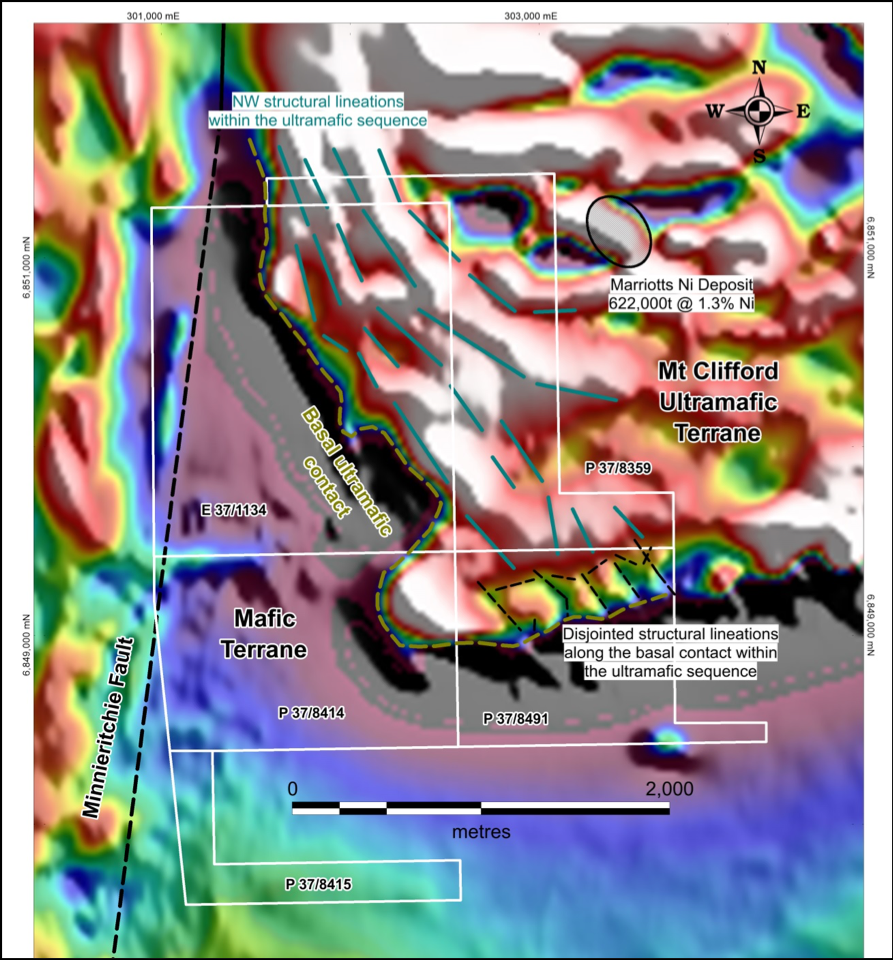The Mt Fouracre Project consists of one (1) Exploration Licence and four (4) Prospecting Licences covering a rectangular area of 7.7 sqkm. The Project is located within the Mt Malcolm District of the Mt Margaret Mineral Field of Western Australia approximately 60km NW of Leonora in the centre of the North Eastern Goldfields. The holding is primarily prospective for nickel sulphide mineralisation (Ni) however in the Eastern Goldfields gold (Au) is always of interest.
The tenement package overlies a major, gently folded, structural flexure of a broad NNW to easterly trending sequence of ultramafic flows and intrusives known as the Mt Clifford Ultramafic Complex. The holding is wedged between the Minnieritchie and Mt Clifford Faults.
The basal members of the complex are considered prospective for nickel – copper (Ni-Cu) sulphides as well as gold – Platinum Group Metal (Au-PGE) mineralisation. The holding hosts magnetically quiet mafic rock (gabbroic/basaltic) units to the south-west separated by a thin cherty, black shale horizon and then magnetically active (ultramafic) rock units to the north-east. The greenstone supracrustals in the Mt Clifford area are dominated by komatiites and high MgO-basalts together with significant mafic intrusions and basalts. Komatiites and thin pelitic and cherty sediments form an integral part of the lava flow sequence.
Several anomalous Ni-Cu-Co zones have been identified within the Mt Fouracre holding via consolidation of geology, drill intersections, soil geochemistry and structural interpretations.
Although explored since the early 1970’s, together with the WMC discovery of the Marriott’s nickel deposit (8,700t of Ni metal), 300m east of P37/8359 the Mt Fouracre tenement package is regarded as underexplored. Lithologically the Marriott’s deposit has been described as an ore zone positioned on an ultramafic – mafic contact with nickel sulphide mineralisation hosted within a central equigranular meta-peridotite unit that sits above a basal meta-gabbro contact.
At the adjoining Marriott’s deposit, the nickel sulphides occur as coarse interstitial blebs or as finely disseminated flecks and stringers in the olivine peridotite (ultramafic) with minor amounts of mineralisation in the underlying skeletal peridotite. The ore zones are contained within three north dipping, sub parallel shoots with the central shoot being the most extensive. The shoots are considered to belong to individual flow units.
Historical geological logging and assay results indicate that the Mt Clifford sequence is a suitable host for magmatic nickel mineralisation. Many historical drill holes, although returning anomalous nickel intersections, have not reached target depth and have not been followed up. Numerous target zones remain untested.
The disjointed basal contact magnetic signature (P37/8491) has not been adequately drill tested and presents a primary structural target. However, its exact position requires accurate delineation. Identification of the basal component of the Mt Clifford ultramafic sequence is required prior to drill testing the ultramafic complex.

The principal exploration target is the basal contact and structurally complex areas within the ultramafic complex that display favourable structure and analogous geology to that defined at the Marriott’s deposit. The basal contact and areas displaying a high magnetic response present as zones that may host a Marriott’s style deposit or a stacked or repeated geological mafic-ultramafic contact. The magnetically active eastern portion of the complex displays a positive ultramafic magnetic signature. The ultramafic complex in its entirety presents as a secondary exploration target based on historical drill results and anomalous soil geochemistry.
Considering the close proximity to the Marriott’s nickel deposit and similar magnetic signatures reflected in the TMI geophysical images the extensive contact zone contained within E37/1134, P37/8395, P37/8414 and P37/8491 presents as a exciting nickel exploration target. Other targets displaying multiple sub-parallel structural lineation reflecting the orientation of the mafic-ultramafic contact and the orientation of the Marriott’s deposit (NNW) have also been identified within the Mt Clifford ultramafic complex. The structures, particularly on P37/8491 are clearly visible on the TMI magnetic images and confined to the magnetically high (ultramafic) sectors of the image. Further structural interpretation utilising high resolution magnetic images is recommended.

